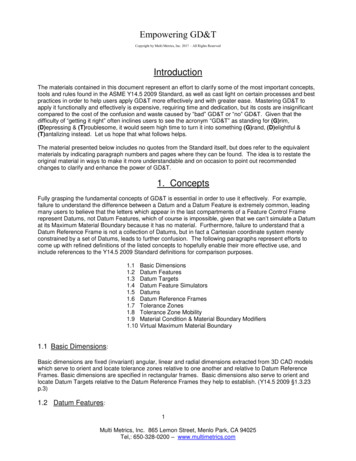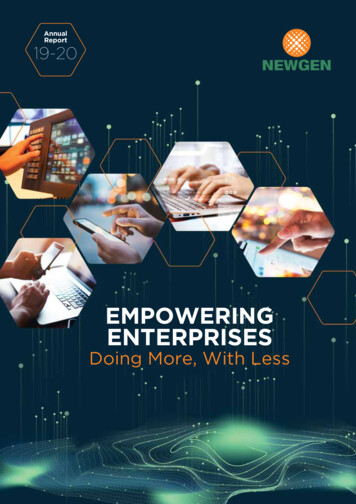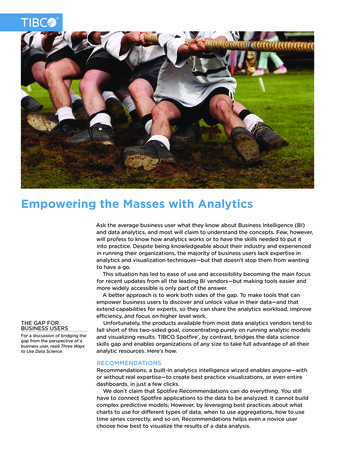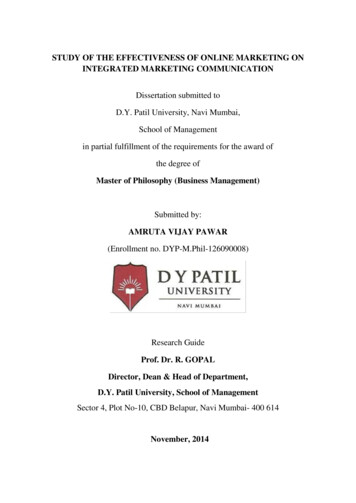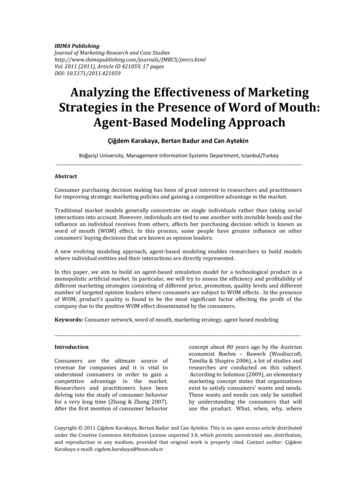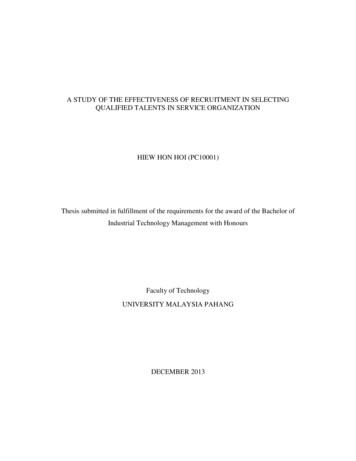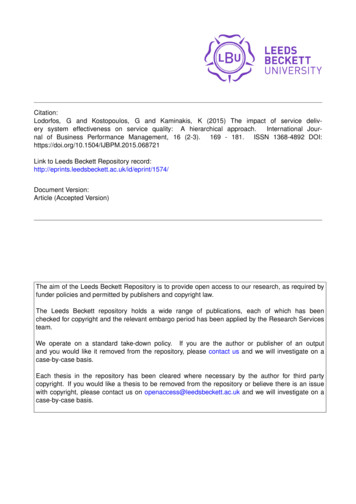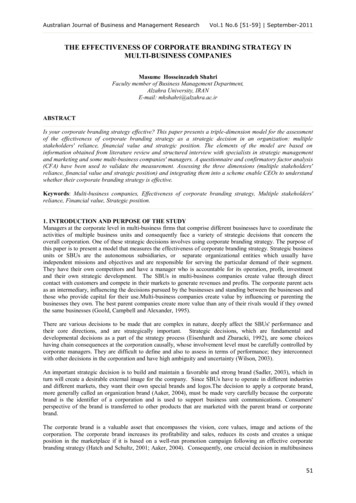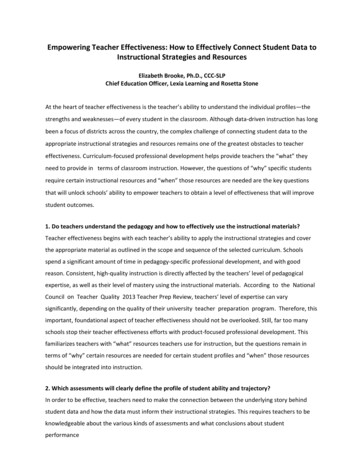
Transcription
Empowering Teacher Effectiveness: How to Effectively Connect Student Data toInstructional Strategies and ResourcesElizabeth Brooke, Ph.D., CCC-SLPChief Education Officer, Lexia Learning and Rosetta StoneAt the heart of teacher effectiveness is the teacher’s ability to understand the individual profiles—thestrengths and weaknesses—of every student in the classroom. Although data-driven instruction has longbeen a focus of districts across the country, the complex challenge of connecting student data to theappropriate instructional strategies and resources remains one of the greatest obstacles to teachereffectiveness. Curriculum-focused professional development helps provide teachers the “what” theyneed to provide in terms of classroom instruction. However, the questions of “why” specific studentsrequire certain instructional resources and “when” those resources are needed are the key questionsthat will unlock schools’ ability to empower teachers to obtain a level of effectiveness that will improvestudent outcomes.1. Do teachers understand the pedagogy and how to effectively use the instructional materials?Teacher effectiveness begins with each teacher’s ability to apply the instructional strategies and coverthe appropriate material as outlined in the scope and sequence of the selected curriculum. Schoolsspend a significant amount of time in pedagogy-specific professional development, and with goodreason. Consistent, high-quality instruction is directly affected by the teachers’ level of pedagogicalexpertise, as well as their level of mastery using the instructional materials. According to the NationalCouncil on Teacher Quality 2013 Teacher Prep Review, teachers’ level of expertise can varysignificantly, depending on the quality of their university teacher preparation program. Therefore, thisimportant, foundational aspect of teacher effectiveness should not be overlooked. Still, far too manyschools stop their teacher effectiveness efforts with product-focused professional development. Thisfamiliarizes teachers with “what” resources teachers use for instruction, but the questions remain interms of “why” certain resources are needed for certain student profiles and “when” those resourcesshould be integrated into instruction.2. Which assessments will clearly define the profile of student ability and trajectory?In order to be effective, teachers need to make the connection between the underlying story behindstudent data and how the data must inform their instructional strategies. This requires teachers to beknowledgeable about the various kinds of assessments and what conclusions about studentperformance
Empowering Teacher Effectiveness: Four Key Factors for SuccessPage 2 of 6can and should be drawn from the data. Ultimately, this level of understanding gives teachers betterclarity of purpose and anticipated outcome—understanding not only what instructional resources areavailable, but also why specific strategies and resources are necessary for each individual in theclassroom.However, we present teachers with a rather daunting task: giving them massive amounts of data andexpecting them to determine “how does this data affect my instructional plan for tomorrow?”Unraveling that challenge begins with a solid understanding of how to use assessment data to clearlydefine a profile of each student’s strengths and weaknesses. According to the National Association ofState Directors of Special Education (NASDE), an accurate profile of student learning in a Response toIntervention model includes several factors: Level of performance – What is the grade level of material on which the student is working? Rate of learning – How quickly is the student making progress towards grade-level standards? Isthe student trending in the right direction and quickly enough to meet expectations? Academic goals – Educators need to establish goals and expectations for each student’s learningand then manage to those goals.Based on these factors, teachers can then adjust the instructional intensity necessary in order to meetthe academic goals. For those students working at or above grade-level, the teacher can extend theacademic goals to encourage students to reach higher levels of achievement. Most importantly, theteacher can set his or her instructional priorities and manage available time and resources to help thestudents who are in the greatest need.What are the types of measures that teachers can use to help plan their instruction and whateducational decisions can be made from these data?Universal screening is typically given at the beginning of the year and is used as a quick indicator ofwhich students are on track and which students require closer monitoring throughout the year. Studentswho are identified at some level of risk are often progress monitored; monthly, weekly, or even daily.
Empowering Teacher Effectiveness: Four Key Factors for SuccessPage 3 of 6Progress Monitoring is a powerful assessment tool in helping teachers determine student profiles andhelp guide and inform their instruction. The overarching purpose of progress monitoring tools is toprovide teachers with information regarding student progress in relation to the instruction/interventionthey are currently receiving. Progress monitoring tools given less frequently (i.e., monthly or three timesa year) are often administered to assess a student’s general reading performance in relation to gradelevel benchmarks/standards and whether students are able to generalize their learning beyond thecurriculum- specific material. Results from these kinds of general progress monitoring tools, often normreferenced measures, are compared to prior results to determine whether the student is makingprogress. If the data show that the student is not making progress, then additional progress monitoringtools, usually associated with a specific curriculum and criterion-based measures, are used for thepurpose of determining how to adjust the instruction/intervention in order for the student to respond.There are now assessment tools available that leverage norm-based measures of progress in order tocreate a student data profile that is predictive of future outcomes on year-end assessments. Predictivedata can provide teachers with an early warning for those students on a trajectory of failure. Byindicating the probability of each student reaching an end-of-year outcome, teachers can prioritize theirtime and act immediately to support students’ instructional needs, rather than waiting for them to fail.Some instructional programs provide embedded assessment—incorporated into students’ daily learning—that can be used in tandem with the informal measures being done on a daily or weekly basis. Severaltech-based curricula offer this kind of real-time data, which can prove to be an efficient and effectivecomponent of your assessment strategy. This not only gives a clearer and more complete view of studentprogress, but it reduces some of the highs and lows associated with testing day anxiety, and ultimatelysaves teachers a significant amount of time typically spent administering and scoring traditionalformative assessments.Diagnostic assessments, although not used as frequently, can be extremely helpful in completing astudent’s profile. When thinking about how diagnostic tests can inform instruction, one main purpose isto provide teachers with additional information that they did not receive from either the screener orprogress monitoring tool. They can also be used in scenarios when the progress monitoring tool’s validityor reliability may be in question (e.g. if the child was sleepy or hungry the day the progress monitoringassessment was given or was especially anxious during the testing). Diagnostic tests can help fine tune
Empowering Teacher Effectiveness: Four Key Factors for SuccessPage 4 of 6instruction and provide more information to understand why a particular student may be struggling.3. Data Analysis: What is your assessment data telling you?The power of collaboration is one of the best ways to empower greater teacher effectiveness. Frequentdata meetings to review, analyze and strategize based on the various kinds of data available help toensure that the proper next steps are taken in order to serve the profiles of all of the students in theclassroom.To a great extent, teacher effectives is impacted by the ability of your data management systems andinstructional resources to help make the connections between the data and the appropriate resourcesand next step in the instructional process. Some instructional programs make automaticrecommendations as to the proper resources based on student data, which can provide significant timesavings and guidance to teachers. By having resources recommendations based on the data, the teachersbegin to learn what certain patterns of data mean and how they can adjust their instruction based ondata.Regardless of whether instructional decisions are ultimately determined by the teachers’ data teams, orwhether they are guided by recommendations within your instructional or assessment technology, dataneeds to be presented in a simple format. On data walls or in your online assessment systems, normreferenced and criterion-based data should clearly define the groups of students who need moreintensive instruction and the groups of students who are on or above level. Analysis should groupstudents by skills areas, and should identify the high-priority students based on their progress towardsyear-end benchmarks. When data is compiled and condensed in this fashion, teachers can moreeffectively plan at a class level, they can more effectively manage their instructional time for whole-classand small group instruction, and administrators can more effectively plan proper resources across gradelevels.How does this look in action?Based on the universal screening assessment, the teacher may already have certain students whoare being closely monitored throughout each lesson. Using curriculum-based progress monitoring,the teacher can administer a type of pre-test by asking questions or having students’ complete
Empowering Teacher Effectiveness: Four Key Factors for SuccessPage 5 of 6grade-level activities. Based on students’ responses, the teacher can identify students whoalready understand a concept before the lesson is taught to the entire class. This process is oftenfacilitated by a technology- based curriculum tool. The advanced students can be pulled aside andprovided with independent activities allowing them to stretch beyond grade level. Knowingwhich students are above level, and where their strengths and weaknesses are, is just asimportant as for those students who are struggling.The teacher provides whole-group instruction on the particular concept, and then gives studentsthe opportunity to practice that particular skill or concept through peer discussions, independentcenter activities or homework assignments. Graded homework assignments and subsequentcurriculum- based tests (such as an end-of-unit quiz) help the teacher understand which studentsmay be struggling and require further instruction.Data from progress monitoring tool is used to help determine the priority of which students needsupport first. Those who are behind grade level and whose progress puts them on a trajectory tonot achieve end-of-year, grade-level expectations should be placed as a priority for the teacher.Those students whose trajectory puts them near, at, or above grade-level might be considered asa lower priority for additional instruction.Using data in this fashion, the teacher can identify students who are struggling, pinpoint the skillson which they are struggling, and then prioritize instruction based on their trajectory towardsend-of-year benchmarks. This planning of instruction helps the teacher to be targeted andtime efficient, prioritizing their investment of time with students in the most urgent need ofhelp first.4. Have you incorporated the right instructional materials for each student’s individual needs?Once the teacher has used various kinds of assessments to identify the various levels of instructionalintensity needed, and then has informed the necessary next steps through analysis of the data andprescriptive strategies from instructional and assessment technology, the final step is delivering smallgroup or individual instruction to the students who are struggling.In every school, there are skilled teachers who have the hands-on experience necessary to support a
Empowering Teacher Effectiveness: Four Key Factors for SuccessPage 6 of 6wide variety of student profiles. For these educators, the question of how to identify the right materialsfor the task may not be a concern. However, for a great number of teachers, determining how to supportspecific student needs may be overwhelming. Therefore, the degree to which principals andadministrators can provide a framework of strategies and resources will help set up their teachers forsuccess.Principals and administrators should insist on resources that are research-based, or better yet, researchproven. This step in the process—intervening with teacher-led, direct instruction—may be the most criticalstep in teacher effectiveness. Therefore, principals should be wary of using homegrown instructionalmethods that are not research based. Fortunately, many comprehensive instructional programs offermaterials for Tier II and Tier III instruction, which are aligned with the pacing and scope of the coreinstruction. If these materials are not part of your instructional program, investing in a research-basedsupplemental program—or investing time and resources in developing methods that are based onscientific research—would be worth considering.The instructional materials should follow a structured routine—such as the Gradual Release ofResponsibility model. A structured approach allows for the students to understand the routine of thelesson, so that they can focus on the lesson material itself, rather than constantly adapting to an everchanging instructional process. A structured approach benefits teachers as well, giving them theopportunity to focus on the language and pacing of the lesson, rather than the instructional frameworkthrough which the lesson is to be delivered.The instructional approach should also include adaptations or alternative lessons for students who donot understand the concept the first time. This provides a true way to reteach the lesson from a differentapproach, rather than just repeating the same lesson over and over. Alternative lesson strategies alsoprovide a way to check whether students have been able to generalize the lesson material, byarticulating the lesson differently and applying the skill in a different context.Instructional materials for intervention should not only provide the appropriate framework—in terms ofpacing and language to use within the lesson—but should also include the appropriate materials.(Depending on the subject area being taught, this could include word lists, equations, reading passages,manipulatives.) Providing these lesson materials, which are linked to the research-based instructional
Empowering Teacher Effectiveness: Four Key Factors for SuccessPage 7 of 6methods, can save teachers a significant amount of time otherwise spent gathering these resourcesthemselves.5. Establish a consistent processOne of the common obstacles to teacher effectiveness is constant organizational change. Far too often,schools change instructional methodologies/programs every few years. In order to be effective in theirrole, teachers must have the opportunity to master the instructional process, and this takes time. Aschool’s assessment framework, data team process, and instructional routines all take time to embraceand internalize.One should not confuse the process for the end goal. Each of the steps covered in this paper support theframework for teacher effectiveness. However, it is only when these processes become second naturefor the school community that the teacher can be free to focus on the end goal of student instruction.Therefore, careful consideration should be brought to decisions regarding instructional materials andestablishing processes.Schools can achieve higher levels of teacher effectiveness by empowering teachers through a shared andclear understanding of core instructional materials, leveraging several kinds of assessments to buildprofiles of student ability, informing instructional priorities through the use of data, leveraging researchbased methodology for intervention, and embracing the process with consistency. A commitment to thiskind of approach benefits teachers, students, administrators and the entire school community.Lexia Learning 2013www.lexialearning.com
Empowering Teacher Effectiveness: How to Effectively Connect Student Data to Instructional Strategies and Resources Elizabeth Brooke, Ph.D., CCC-SLP Chief Education Officer, Lexia Learning and Rosetta Stone At the
